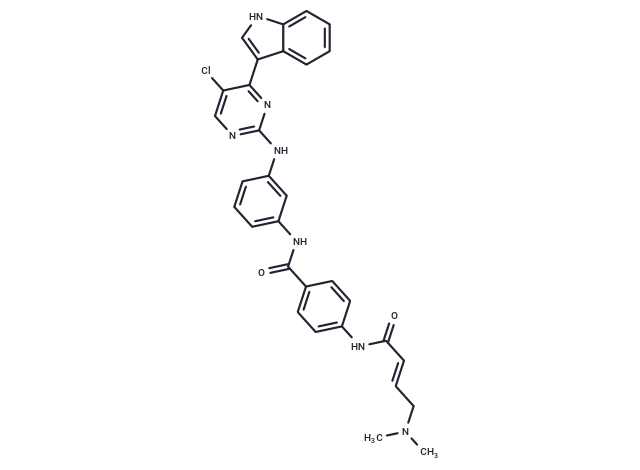Shopping Cart
- Remove All
 Your shopping cart is currently empty
Your shopping cart is currently empty

THZ1 (CDK7 inhibitor) is a selective covalent inhibitor of CDK7, exhibiting binding affinity to the cysteine residue located at the outer end of the classical kinase domain, thus conferring high selectivity for CDK7, with an IC50 of 3.2 nM.

| Pack Size | Price | Availability | Quantity |
|---|---|---|---|
| 5 mg | $81 | In Stock | |
| 10 mg | $140 | In Stock | |
| 25 mg | $239 | In Stock | |
| 50 mg | $369 | In Stock | |
| 100 mg | $498 | In Stock |
| Description | THZ1 (CDK7 inhibitor) is a selective covalent inhibitor of CDK7, exhibiting binding affinity to the cysteine residue located at the outer end of the classical kinase domain, thus conferring high selectivity for CDK7, with an IC50 of 3.2 nM. |
| Targets&IC50 | CDK7:3.2 nM |
| In vitro | THZ1 uses a unique mechanism, combining ATP-site and allosteric covalent binding, as a means of attaining potency and selectivity for CDK7. THZ1 irreversibly inhibits RNAPII CTD phosphorylation by covalently targeting a unique cysteine located outside the kinase domain of CDK7. THZ1, but not THZ1-R, completely inhibits the phosphorylation of the established intracellular CDK7 substrate RNAPII CTD at Ser?5 and Ser?7, with concurrent loss of Ser?2 phosphorylation at 250?nM in Jurkat cells. THZ1 exhibits strong antiproliferative effects across a broad range of cancer cell lines from various cancer types. In Jurkat cells, low-dose THZ1 has a profound effect on a small subset of genes, including the key regulator RUNX1, thus contributing to subsequent loss of the greater gene expression program and cell death[1]. THZ1 causes defects in Pol II(polymerase II) phosphorylation, co-transcriptional capping, promoter proximal pausing, and productive elongation[2]. |
| In vivo | THZ1 reduces the proliferation of KOPTK1 T-ALL cells in a human xenograft mouse model. THZ1 is well tolerated at 10 mg/kg with no observable body weight loss or behavioural changes, suggesting that it causes no overt toxicity in the animals[1]. |
| Kinase Assay | For kinase assays following immunoprecipitation of FLAG-CDK7 protein from HCT116 or FLAG-CDK12 from 293A cellular lysates, cells are first treated with THZ1, THZ1-R, or DMSO for 4 hrs at 37°C. Cells are then harvested by lysis in 50 mM Tris HCl pH 8.0, 150 mM NaCl, 1% NP-40, 5 mM EDTA, and protease/phosphatase cocktails. Exogenous CDK7 or CDK12 proteins are immunoprecipitated from cellular lysates using FLAG antibody- conjugated agarose beads. Precipitated proteins are washed with lysis buffer 6 times, followed by 2 washes with kinase buffer (40 mM Hepes pH 7.5, 150 mM NaCl, 10 mM MgCl2, 5% glycerol) and subjected to in vitro kinase assays at 30°C for 45 minutes using 1 μg of the large subunit of RNAPII (RPB1) as substrate and 25 μM ATP and 10 μCi of 32P ATP. Kinase assays using recombinant CDK7/TFIIH/MAT1 are conducted in the manner as described above using 25 ng of CAK complex per reaction. For kinase assays designed to test time-dependent inactivation of CDK7 kinase activity, CAK complex is pre-incubated with indicated concentrations of THZ1, THZ1-R, or DMSO in kinase buffer without ATP for 4 hrs at 30°C prior to being subjected to kinase assay conditions[1]. |
| Cell Research | Cells are treated with THZ1, THZ1-R or dimethylsulphoxide (DMSO) for 0-6?h to assess the effect of time on the THZ1-mediated inhibition of RNAPII CTD phosphorylation. For subsequent experiments cells are treated with compounds for 4?h as determined by the time-course experiment described earlier, unless otherwise noted. For inhibitor washout experiments, cells are treated with THZ1, THZ1-R or DMSO for 4?h. Medium containing inhibitors is subsequently removed to effectively 'washout' the compound and the cells are allowed to grow in the absence of inhibitor. For each experiment, lysates are probed for RNAPII CTD phosphorylation and other specified proteins.(Only for Reference) |
| Alias | THZ1 2HCl, CDK7 inhibitor |
| Molecular Weight | 566.05 |
| Formula | C31H28ClN7O2 |
| Cas No. | 1604810-83-4 |
| Smiles | CN(C)C\C=C\C(=O)Nc1ccc(cc1)C(=O)Nc1cccc(Nc2ncc(Cl)c(n2)-c2c[nH]c3ccccc23)c1 |
| Relative Density. | 1.379 g/cm3 (Predicted) |
| Storage | Powder: -20°C for 3 years | In solvent: -80°C for 1 year | Shipping with blue ice. | ||||||||||||||||||||||||||||||
| Solubility Information | Ethanol: < 1 mg/mL (insoluble or slightly soluble) DMSO: 50 mg/mL (88.33 mM), Sonication is recommended. | ||||||||||||||||||||||||||||||
Solution Preparation Table | |||||||||||||||||||||||||||||||
DMSO
| |||||||||||||||||||||||||||||||

Copyright © 2015-2025 TargetMol Chemicals Inc. All Rights Reserved.